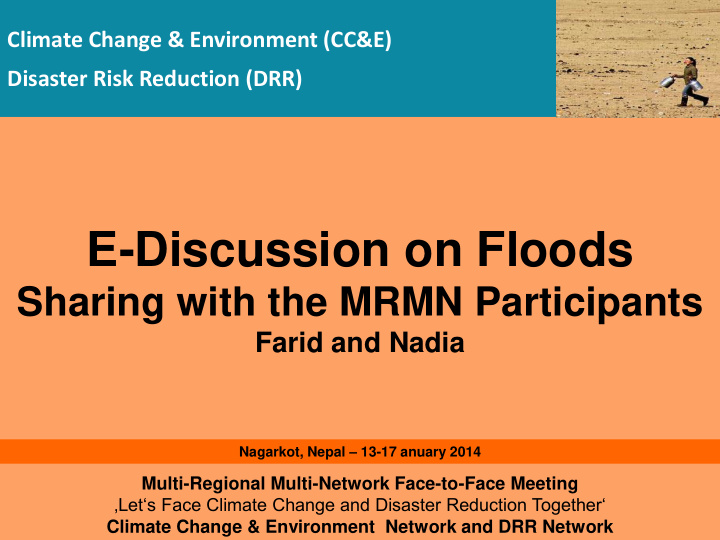



Federal Department of Foreign Affairs FDFA Climate Change & Environment (CC&E) Swiss Agency for Development and Cooperation SDC Corporate Domain Global Cooperation / Global Program Climate Change (GPCC) Disaster Risk Reduction (DRR) Corporate Domain Humanitarian Aid / Multilateral Division E-Discussion on Floods Sharing with the MRMN Participants Farid and Nadia Nagarkot, Nepal – 13-17 anuary 2014 Multi-Regional Multi-Network Face-to-Face Meeting ‚Let‘s Face Climate Change and Disaster Reduction Together‘ Climate Change & Environment Network and DRR Network
Summary of the Presentation Why E-discussion Characteristics of floods in Asia E discussion organisation and Participation Questions Contributions Synthesis Observation Open questions to further explore the topic
Why E-Discussions Collaboratively explore the issues related to Climate Change, Environment and Disaster Risk Reduction Better understanding the inter-linkages between the respective CC&E and DRR contexts and rationales Warm up for F2F/January Events
Characteristics of floods in Asia/S. Asia 1/2 Asia is the largest and most populous continent on Earth. The Asian monsoons classified into a few sub-systems, South Asian Monsoon and and the East Asian Monsoon Nepal, India and Bangladesh share a common eco- hydrology and a common disaster – floods.
Characteristics of floods in Asia/S Asia 2/2 Flash floods caused by overflowing of rivers (in April-May and September-November). Rain floods caused by drainage congestion and heavy rains. Monsoon floods caused by major rivers (during June- September). Mud floods Coastal floods caused by storm and tidal surges.
Organisation and participation E-discussion on Floods started on 22 Nov and finished on the 9 Dec2013 Started with two initial questions (no. 5 & 6) followed by three more questions (no. 7 & 8 & 9): 19 participants from 11 countries actively engaged and contributed
Initial Questions Question no. 5: How are floods impacting your country/region and what are their underlying causes? Question no. 6: What is done (structural and non-structural measures) to enhance the resilience of people at risks of floods at different level (communities, national, regional) and what are the limits faced in your context and in your organization?
Questions Question no. 7: What could be done at different level to reduce flood risks in your working area/country/region? Question no. 8: What can / must be done to mainstream DRR as part of integrated risk management to counter flood risks, and what are the main challenges? Question no. 9: What can be done to better coordinate DRR and CCA efforts at different levels (local to regional)?
Contributions against questions Question based Context focus General and specefic Project oriented
Q5: How are floods impacting your country/region and what are their underlying causes? floods, mudflows and flash-floods hazards of various magnitudes Lives, livelihoods and public infrastructures are affected The exposure of people and assets in hazard zones The raise of temperature and changes of rain patterns The inappropriate use of land An over exploitation of the natural resources Clogged drainage systems by solid wastes poorly managed in urban settings or by easily uprooted trees
Q6: What is done to enhance the resilience of people at risks of floods at different level and what are the limits faced in your context and in your organization? Contexts vary in the region. Many countries have developed a national strategy for DRR Structural measures are common in the region to protect against floods but have their limit in the design & costly in maintenance and need to be combined with soft measures Other measures such as EWS still need more investments in Hydro Met data collection to be effective on time There’s a lack of cross-border cooperation
Q7: What could be done at different level to reduce flood risks in your working area/country/region? Effective trans-boundary dialogue and sharing of hydro met data Each context is different and should be treated accordingly The risk of flood has to be managed at watershed level Conflict sensitive approach is necessary for sustainable solutions Link disaster risk reduction and natural resources management with livelihood opportunities for local communities
Q8: What can / must be done to mainstream DRR as part of integrated risk management to counter flood risks, and what are the main challenges? More awareness at all level on the need for an integrated risk management approach Proper guidelines available for all levels and sectors on DRR integration DRR measures must be aligned with poverty reduction, creation of livelihood Difficulties to find consensus among different interests
Q 9: What can be done to better coordinate DRR and CCA efforts at different levels (local to regional)? Reg. : An effective coordination National level: DRR Policy adapted to the context Implementation of Standing Order on Disaster Coordination between Go and the NGOs Local level: Flood proof housing, Livelihoods Adaptive cropping practices, Livestock based agriculture, Tree Plantation Employment oriented education, Special health services Ensure community participation
Synthesis Risks of disasters results from a complex interaction of factors Each context is very different Lack of communication among the different actors is highlighted as one of the main causes of floods all throughout the e- discussion Floods management request a strong political will to invest raising awareness of the population, maintaining infrastructures, and land use plans
Observations Good start for Facing Climate Change and Disaster Risks Together A Lot of ideas, experiences and views Alignment with poverty and Sust.Devt. Both Rural and Urban environments have been presented Less focus on economic systems Community participation has been several mentioned but little has been said about decentralization and the role of local authorities
Issues/questions to further explore the topic 1/2 Integrated risk management and sustainable development Policy implementation approach of DRR/ natural resources management Risk reduction in local agendas of development. Legislation and rule of law Task for cooperation organizations
DHONNOBAD Thank you very much
Recommend
More recommend